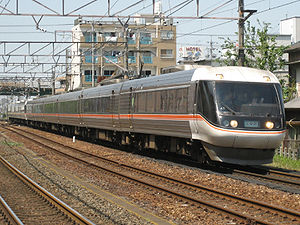Shinano (train)
 383 series electric train on a Shinano service in May 2007 | |
| Overview | |
|---|---|
| Service type | Limited express |
| Status | Operational |
| First service | 11 November 1953 (Semi-express) 13 December 1959 (Express) 1 October 1968 (Limited express) |
| Last service | 26 March 2016 (Nagano - Ōsaka service) |
| Current operator(s) | JR Central / JR East |
| Former operator(s) | JNR |
| Route | |
| Start | Nagoya |
| Stops | 15 |
| End | Nagano |
| Distance travelled | 250.8 km (155.8 mi) |
| Average journey time | 2 hours 55 minutes approx |
| Service frequency | Approximately one train an hour in each direction |
| Line(s) used | Chūō Main Line, Shinonoi Line, Shin'etsu Main Line |
| On-board services | |
| Class(es) | Green + Standard |
| Disabled access | Yes |
| Seating arrangements | 2+2 unidirectional |
| Sleeping arrangements | None |
| Catering facilities | None |
| Observation facilities | None |
| Entertainment facilities | None |
| Other facilities | Toilets |
| Technical | |
| Rolling stock | 383 series EMU |
| Track gauge | 1,067 mm (3 ft 6 in) |
| Electrification | 1,500 V DC |
| Operating speed | 130 km/h (81 mph)[1] |
| Track owner(s) | JR Central, JR East |
The Shinano (しなの), branded as (Wide View) Shinano ((ワイドビュー)しなの) is a limited express train service in Japan operated by Central Japan Railway Company (JR Central), which runs between Nagoya and Nagano via Matsumoto.[1] Like all JR Central limited express trains, a limited express fee has to be paid, on top of the normal fare to ride this service. Until 26 March 2016, after which it was discontinued, there was a daily return service which ran from Nagano to Ōsaka, which travelled a total distance of 441.2 km (274.1 mi), making the Shinano the furthest travelling limited express service in Japan with the whole journey taking approximately 5 hours 30 minutes.
Route[]
Trains start or terminate at Nagoya Station. There was a daily return service between Nagano and Ōsaka, which travelled a total distance of 274.1 miles (441.2 km), taking approximately 5 hours 30 minutes, once making the Shinano Japan's furthest travelling limited express service. The service was discontinued on 26 March 2016, due to declining passenger numbers. In the past, some trains also ran seasonally to Hakuba station but these ceased operations too.
Trains stop at the following stations:
Nagoya - (Kanayama) - Chikusa - Tajimi - (Ena) - Nakatsugawa - (Nagiso) - (Agematsu) - Kiso-Fukushima - Shiojiri - Matsumoto - (Akashina) - (Hijiri-Kōgen) - Shinonoi - Nagano
Stations in brackets indicate the stations where not all Shinano services stop at.
Rolling stock[]
- 383 series 6-, 8-, or 10-car EMUs (since 1 December 1996)[1]
Past[]
- KiHa 181 series DMUs (1968–1972)
- 381 series EMUs (1972–2008)

Preserved JNR KiHa 181 series DMU car

381 series EMU on a seasonal Shinano service, July 2006
Accommodation[]
Green car (first class) and standard class accommodation is provided, with 2+2 abreast unidirectional seating in both classes.[1] Seat pitch is 1,200 mm (47 in) in Green class and 1,000 mm (39 in) in standard class.[1] All trains are no smoking. Onboard catering services ceased on 16 March 2013.
History[]
The Shinano service was first introduced on 11 November 1953 as a "semi-express" operating between Nagoya and Nagano.[2] This was upgraded to "express" status from 13 December 1959, and became a "limited express" from 1 October 1968.[2]
References[]
- ^ Jump up to: a b c d e JR新幹線&特急列車ファイル [JR Shinkansen & Limited Express Train File]. Japan: Kōtsū Shimbun. 2008. p. 32. ISBN 978-4-330-00608-6.
- ^ Jump up to: a b 列車名鑑1995 [Train Name Directory 1995]. Japan: Railway Journal. August 1995. p. 126.
External links[]
| Wikimedia Commons has media related to Shinano (train). |
- JR Central Shinano information (in Japanese)
- Central Japan Railway Company
- Named passenger trains of Japan
- Railway services introduced in 1953


